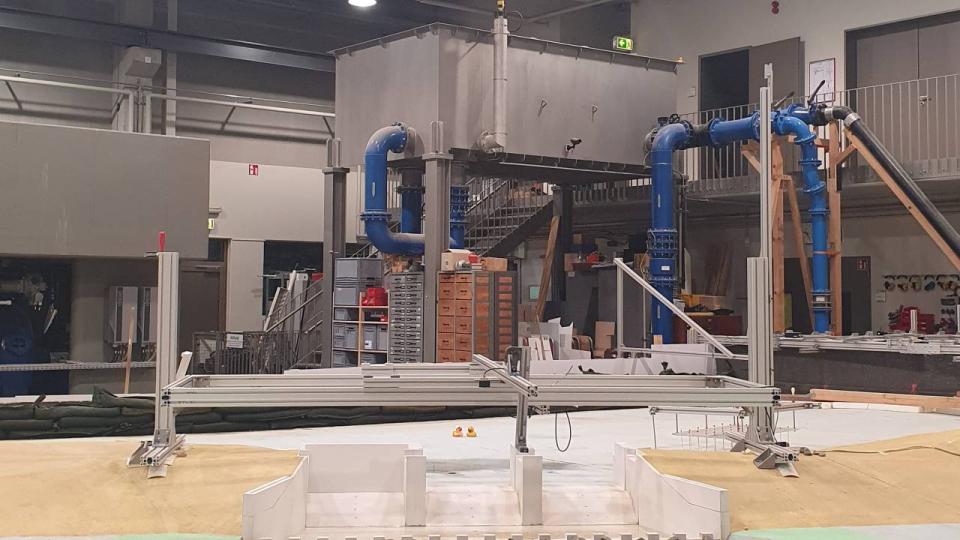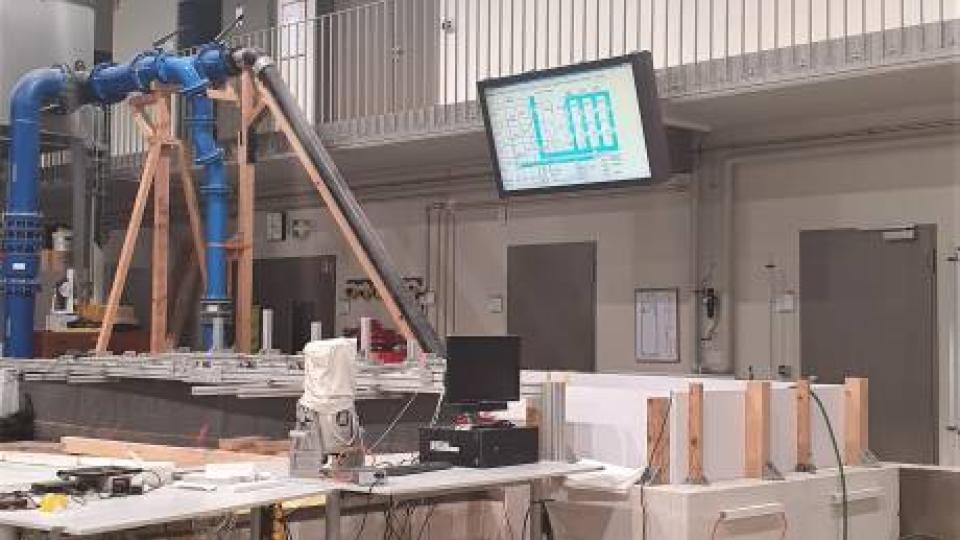Hyejin Im reports
On the 23 June and the 3 July, I visited Hubert Engels Laboratory of Institute of Hydraulic Engineering and Technical Hydromechanics (IWD) in TU Dresden. Along with UNU-FLORES, TU Dresden – specifically IWD – is part of the Global Water and Climate Adaptation Centre (ABCD Centre), with Dresden represented by the ‘D’ in ‘ABCD’ (with the other letters standing for ‘Aachen’, ‘Bangkok’, and ‘Chennai’, respectively). The IWD researches a wide range of topics in the field of hydraulics and hydrodynamics using physical and numerical models. As a member of the guided tour, I was given the rare opportunity to view three physical models of on-going projects in various stages of development.


Model 1 – Data Display
The first of the three was a physically downscaled model of a polder for flood management, which investigates the characteristics of water flows through the weir and spillways with their impacts on the local riverbeds. The sensors attached to both sides of the weir measure hydrodynamic data that is compared with results of numerical models. The research has a significant influence on flood management in the Elbe River and goes hand in hand with the ongoing efforts to improve disaster preparedness and climate resilience in the wake of a severe flooding event experienced by the city in 2002.
![3-Model-2_hydraulic-channels-for-tracking-fish-pathways-and-behaviors-460x260[1].jpg](/sites/default/files/styles/16_9_large/public/2024-04/3-Model-2_hydraulic-channels-for-tracking-fish-pathways-and-behaviors-460x260%5B1%5D.jpg?h=bccd1fa5&itok=eI9rCIpy)
![4-Model-2_Fish-containers-460x260[1].jpg](/sites/default/files/styles/16_9_large/public/2024-04/4-Model-2_Fish-containers-460x260%5B1%5D.jpg?h=bccd1fa5&itok=pVAKGPIQ)
Model 2 – Fish Containers
The second model, falling into the field of eco-hydraulics, was one that particularly captured my interest. It tracks the 3D-routes of real fish in the hydraulic channels using multiple cameras to identify the possible influences on fish movement behaviour along their migration routes. Given our planet’s ongoing biodiversity loss, and an increased pressure on water supply systems to keep up with water demand, this model is especially relevant in that it adds to our understanding of how the alteration of river systems can affect the river ecology, which also can be the starting point to approach sustainable river management.
![5-Model-3_-a-pit-lake-model-with-a-wave-generator-on-the-top-1280x720[1].jpg](/sites/default/files/styles/16_9_large/public/2024-04/5-Model-3_-a-pit-lake-model-with-a-wave-generator-on-the-top-1280x720%5B1%5D.jpg?h=c673cd1c&itok=SHJL9D15)
The last model was an opencast pit-lake model that tests soil erosion characteristics, with or without plants, by generating artificial waves from a distance. Using soil samples from the former coal mining regions and a protective layer on the top, this model allows researchers to study how wind-induced waves and changing water levels alter the shoreline geometry of the pit lake and influence its stability. These findings are very pertinent to the coal phase-out initiative across Germany, and mainly focuses on the Lusatian region.
It was a truly valuable experience to see the various physical models in action, and to learn how these physical and numerical models can complement each other to broaden knowledge on water management. Considering that many water issues are caused by the poor management of water resources, understanding both natural and artificial water systems is a much-needed step to address management issues and achieve sustainable water management under the threat of climate change. Furthermore, from a nexus perspective, water systems have a strong relevance to the production of energy (e.g., hydroelectric dams), food (e.g., irrigation reservoirs or channels), and conserving ecosystems (e.g., environmental impacts of large dams). Therefore, it can be said that uncovering how hydrological and hydraulic systems change water flows and environments is the key to climate adaptation. In this sense, I strongly believe that the ABCD Centre project is vital in its contributions to knowledge building on water-related climate adaptation, with the potential for this knowledge base to be a hugely useful resource to decision-makers and other stakeholders.
![Re-sized-photo-449x260[1].jpg](/sites/default/files/styles/16_9_large/public/2024-04/Re-sized-photo-449x260%5B1%5D.jpg?h=40e1a37d&itok=TT91_JBD)
Hyejin getting in on the action!
About the Author: Hyejin Im has been a research intern at UNU-FLORES since May 2023 through the Global Environmental Leaders Program sponsored by the Korea Environment Corporation (K-eco), which collaborates closely with UNU-FLORES. Her work at UNU-FLORES focuses on water resources management and water governance under the supervision of Dr Serena Caucci.


